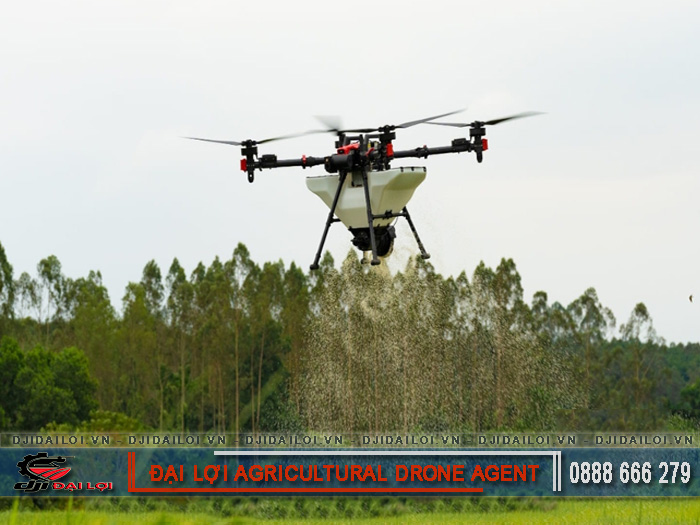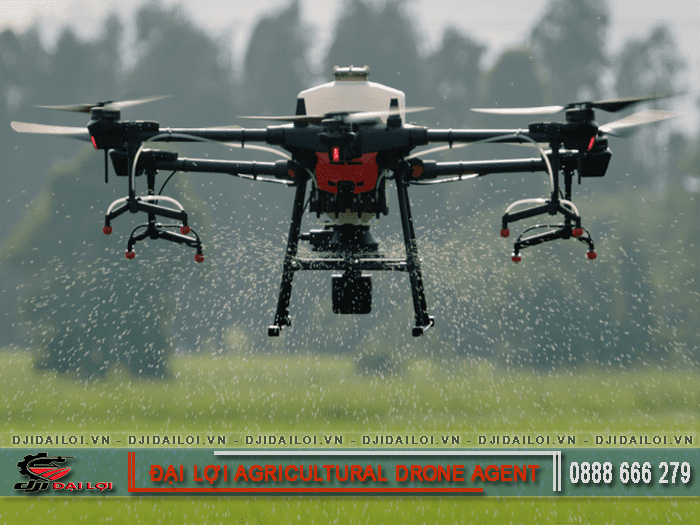What is a fertilizer drone? Advantages and efficient operation
In the agricultural technology revolution, fertilizer drones have emerged as a modern solution that allows farmers to spread fertilizers accurately over large areas. However, to understand what makes a fertilizer drone different, how it works, and whether it truly delivers benefits, we need to look at its structure, pros and cons, and practical considerations when applying it.

Overview of agricultural fertilizer drones
In modern agriculture, when we mention fertilizer drones, most people immediately think of unmanned aerial vehicles (UAVs) used to spread fertilizer over soil or crops. However, to understand their true nature and differentiate them from similar technologies, we need a clear definition.
What is a fertilizer drone?
A fertilizer drone is an agricultural UAV (unmanned aerial vehicle) specifically designed or equipped with a fertilizer spreading system (for powder, granules, solid, or mixed materials) that distributes fertilizer over the ground or crop canopy. It may also perform additional agricultural tasks such as pesticide spraying or seed sowing.
Fertilizer drones typically operate along pre-programmed routes, with flight altitude, speed, and spreading flow precisely controlled to ensure even distribution neither too dense nor scattered outside the target area.
The role of fertilizer drones in agricultural technology
- Fertilizer drones belong to the UAV (drone) technology segment in smart agriculture. They are “mission variants” of agricultural drones that perform tasks such as spraying pesticides, multispectral imaging, spreading fertilizers, or sowing seeds.
- They help transition from traditional manual farming to precision and automated agriculture, optimizing fertilizer use, reducing waste and pollution, and increasing production efficiency.
- Unlike pure spraying drones, fertilizer drones focus on carrying and precisely distributing solid materials, rather than spraying liquids onto leaves.
Therefore, when you hear terms such as “fertilizer spreading drone,” “fertilizer UAV,” or “agricultural drone for fertilizer application,” they essentially refer to the same concept with differences mainly in design or function.
Structure and working principle of agricultural fertilizer drones
Main components
From an engineering perspective, a fertilizer drone typically includes:
- Airframe and flight structure: The main body, wings (for fixed-wing drones), or rotors (for multi-rotor drones). → Materials: aluminum alloy, carbon fiber, or lightweight composite for optimal strength-to-weight ratio.
- Motors, propulsion, and rotors: Provide lift, direction, and stability. → In multi-rotor drones, each rotor has an independent motor whose speed can be adjusted for precise flight control.
- Flight controller (FC): Receives data from sensors, GPS/RTK, and ground stations → Coordinates motor outputs to maintain altitude, balance, and trajectory.
- Navigation and positioning system: Combines GPS, GNSS, and RTK (Real-Time Kinematic) to achieve centimeter-level accuracy. → Advanced models also include barometric sensors, obstacle detection, and small radar modules for collision avoidance.
- Fertilizer tank and spreading system: Holds fertilizer material (solid or granular) → The spreading mechanism may include a delivery tube, spinner disc, or vibrating rotor to control output rate according to flight speed.
- Remote control and communication system: The ground station interface allows route planning, speed setting, and fertilizer flow adjustment → Communication uses radio, 4G/5G, or RTK transmission channels.
- Power supply (battery or fuel): Electric drones use LiPo or high-energy batteries, while hybrid or fuel-based models combine internal combustion with electric generation.
- Auxiliary systems: Safety sensors, temperature and humidity monitors, return-to-home functions, and protective modules.
Operating principle
The operation process of a fertilizer drone generally includes:
- Mapping and route planning: The operator defines the target area, inputs coordinates, and sets flight routes, altitude, and speed using RTK for high precision.
- System check: The drone is powered on, battery and structure checked, spreading system tested, and communication established.
- Takeoff and positioning: The drone ascends to the starting point and stabilizes its flight path using data from GPS and sensors.
- Fertilizer spreading: Upon reaching the designated area, the control system activates the spreading module, adjusting output according to flight speed to maintain even coverage.
- Return and maintenance: After finishing, the drone returns automatically or lands at a safe location. The operator cleans the system, checks leftover fertilizer, and inspects battery and mechanics.
- Post-flight analysis: Distribution results are verified via aerial images or sampling to fine-tune future spreading parameters.
Through synchronized flight control and spreading systems, fertilizer drones can efficiently distribute fertilizers over large areas with minimal manual intervention.
Types of fertilizer drones
By terrain and operating conditions
- Flatland or paddy-field drones:
Large payloads and high-capacity tanks, fewer obstacle sensors, capable of covering wide areas quickly.
- Mountainous or hilly terrain drones:
Equipped with obstacle avoidance sensors, radar, or lidar for safe operation in complex environments.
By mission type
- Single-purpose drones: Designed solely for fertilizer spreading simpler and cheaper.
- Multi-purpose drones (3-in-1 or 4-in-1): Combine fertilizer spreading, spraying, and seed sowing (e.g., PG80, P80).
- Modular systems: Allow switching between fertilizer and spraying modules depending on the season.
By size and payload
- Small to medium drones: Payloads of a few dozen kilograms, suitable for small to mid-size farms.
- Large-capacity drones: Heavy payloads and big tanks ideal for large farms or agribusinesses. For example, the DJI brand has the DJI Agras T50 series that can carry up to 50 kg of fertilizer.
Are fertilizer drones effective? Pros and cons
Advantages
- Save time and labor: Cover large areas quickly compared to manual spreading.
- High accuracy and consistency: GPS-guided spreading ensures uniform coverage.
- Reduce fertilizer waste: Targets specific zones, minimizing off-target loss.
- Environmentally friendly: Reduces nutrient runoff and soil or water pollution.
- Operate in difficult terrain: Work efficiently even in flooded or muddy fields.
- Integrate smart technology: Can map, monitor, and optimize fertilizer rates using AI and sensors.
- Enhance worker safety: Minimize direct contact with chemical fertilizers.
Disadvantages and challenges
- High initial investment: Drones, RTK systems, and modules are costly.
- Dependence on technical accuracy: Poor calibration or route planning can cause uneven spreading.
- Requires skilled operators: Users must understand flight control and error handling.
- Weather limitations: Strong winds or rain affect stability and precision.
- Maintenance and spare parts costs: Require reliable after-sales service.
- Legal restrictions: In many regions, UAV fertilizer spreading requires permits under civil aviation laws.
Comparison: fertilizer drones vs traditional methods
|
Criteria
|
Traditional (manual/mechanical)
|
Fertilizer drone
|
|
Time and labor
|
Labor-intensive
|
Fast, labor-saving
|
|
Distribution uniformity
|
Hard to maintain
|
Highly precise
|
|
Access to difficult terrain
|
Limited
|
Easy to access
|
|
Investment cost
|
Low
|
High initial cost
|
|
Environmental impact
|
Higher fertilizer loss
|
Lower pollution
|
|
Worker exposure
|
Direct contact
|
Safer, minimal exposure
|
Overall, fertilizer drones deliver superior performance in many conditions, but their efficiency depends on technical management and suitable investment.

Applications and real-world use
In agricultural production
- Rice farming: Widely used for large paddy fields, especially during key fertilizing seasons.
- Orchards and industrial crops: Spread fertilizer around tree bases or canopy zones.
- Mountainous or small plots: Compact drones can safely navigate obstacles.
- Smart agriculture integration: Combine soil and NDVI data for precision nutrient mapping.
- Service models: UAV companies offer fertilizer-spreading services to farmers, reducing the need for individual drone ownership.
User benefits
- Lower production costs: Reduce fertilizer use and labor expenses.
- Higher yield and crop quality: Uniform fertilization enhances nutrient uptake.
- Faster and more stable operations: Complete fertilization on schedule.
- Alignment with modern agriculture trends: Supports digital transformation and sustainable farming.
Role in the agricultural ecosystem
- Part of precision agriculture: Acts as the “hands” of smart farming systems.
- Reduces emissions and runoff: Promotes cleaner soil and water.
- Optimizes national resources: Addresses labor shortages while maintaining productivity.
- Promotes agricultural tech industries: Supports UAV training, rental, and maintenance sectors.
- Drives transformation: Encourages adoption of sustainable, data-driven agriculture.
Example in Vietnam: UAVs like the DJI Agras T20 can spread 15 kg/min, covering 30+ ha per day, and are now used by local drone service providers.
Misconceptions when using fertilizer drones and how to avoid them
Common misconceptions and correct explanations
- “A fertilizer drone is just a renamed spraying drone” → Although some drones can both spray and spread, their systems and physics differ spreading solid fertilizer requires mechanical dispersion, not liquid spraying.
- “Anyone can use it it’s fully automatic” → Efficiency depends on route planning, calibration, and correct parameter setup. Poor operation may cause waste or uneven spreading.
- “It’s too expensive to be worth it” → For small-scale farms, costs may outweigh benefits. Consider area size and usage frequency before investing leasing UAV services can be more practical.
- “Using drones replaces traditional methods completely” → Some small plots or field edges still require manual or mechanical application.
When not to use fertilizer drones
- Farms that are too small or fragmented inefficient for drone use.
- During bad weather (strong winds, rain, fog) reduces accuracy and safety.
- Where maintenance or technical support is unavailable.
- In regions where UAV fertilizer spreading is restricted always check local aviation laws.
- When financial capacity is limited the cost may exceed the potential return.
Fertilizer drones mark a significant advancement in precision agriculture reducing fertilizer loss, saving labor, and improving productivity. Despite challenges in cost and regulation, when applied correctly and at suitable scales, they offer real value to farmers and agricultural enterprises. Understanding the essence of fertilizer drone technology is key to making informed investment and operational decisions.
FAQ: Agricultural fertilizer drones
Do fertilizer drones require flight permits?
Yes. In Vietnam, UAVs used for fertilizer spreading must comply with the Civil Aviation Authority’s regulations, including registration and flight zone approval.
Which type of fertilizer drone suits farms under 5 hectares?
Lightweight or compact drones are recommended. Alternatively, consider renting UAV services to save cost and reduce operational risks.
Can fertilizer drones spread liquid fertilizer?
No. They are designed for solid or granular fertilizer. Liquid fertilizers require specialized spraying drones with corrosion-resistant pumps and nozzles.
What is the maximum fertilizer tank capacity?
Depending on the model, capacity ranges from 10 L to over 50 L. Advanced drones like the DJI Agras T50 can carry up to 50 kg, covering more than 30 ha per day.
Can the spreading rate be calibrated for different soil types?
Yes. Operators can adjust flight height, speed, and output rate manually or automatically. Some modern systems integrate nutrient maps for autonomous variable-rate spreading.

